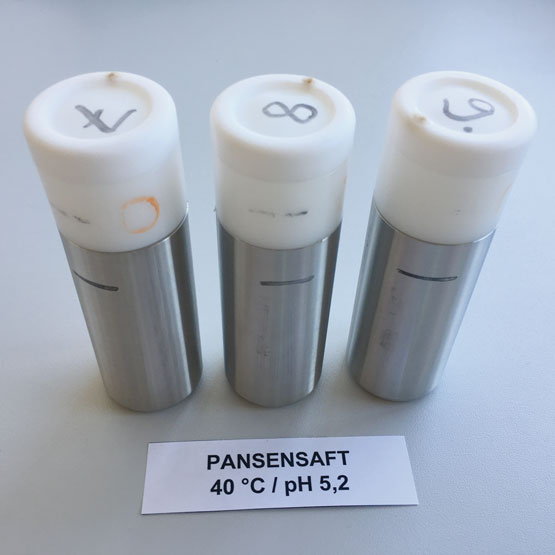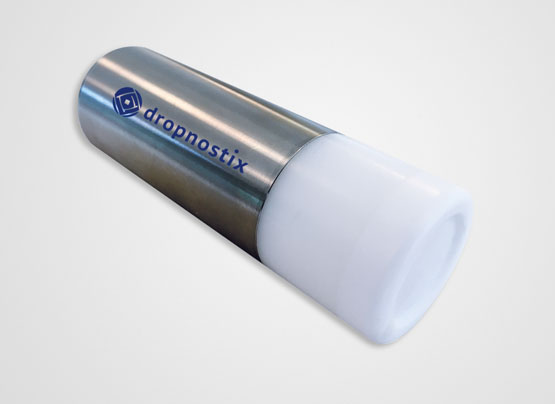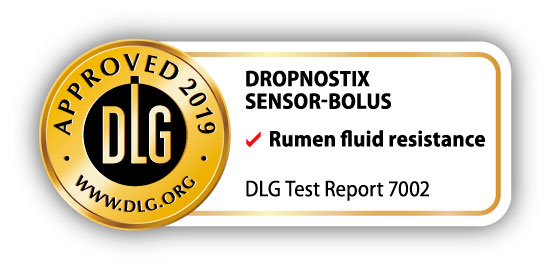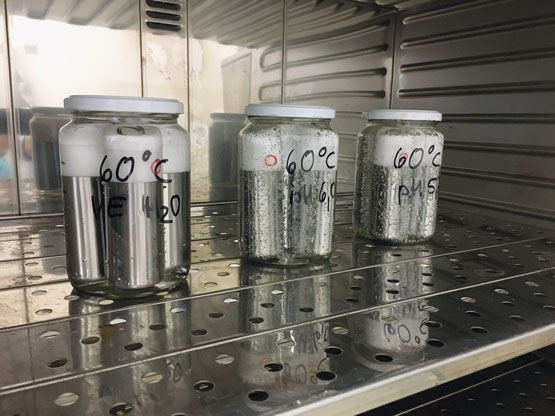dropnostix GmbH Rumen sensor dropnostix Sensor-Bolus
DLG-APPROVED "Rumen fluid resistance"
A test mark „DLG-APPROVED for individual criteria“ is awarded for agricultural products which have successfully fulfilled a scope-reduced usability testing conducted by DLG according to independent and recognized evaluation criteria. The test is intended to highlight particular innovations and key criteria of the test object. The test may contain criteria from the DLG test scope for overall tests, or focus on other value-determining characteristics and properties of the test subject. The minimum requirements, test conditions and procedures as well as the evaluation bases of the test results will be specified in consultation with an expert group of DLG. They correspond to the recognized rules of technology, as well as scientific and agricultural knowledge and requirements. The successful testing is concluded with the publication of a test report, as well as the awarding of the test mark which is valid for five years from the date of awarding.
In this test, the resistance of the materials of a rumen sensor housing to artificially produced rumen fluid was tested in the laboratory on the basis of DIN EN ISO 175. The DLG test framework for rumen sensors, status 2014, was used as the basis for this. No other criteria were investigated.
Assessment in brief
The rumen sensor ‘dropnostix Sensor-Bolus’, a two-piece special bolus for cattle with an internal battery and sensors for measuring the temperature, movement and digestive activity, was investigated as regards its resistance to rumen fluid in a laboratory test under physiological and acidosis conditions in the DLG-APPROVED for individual criteria test. The materials used for the rumen sensor housing, including the adhesive, proved to be resistant under all of the test conditions. Fluid ingress was not observed on any of the test samples.
Table 1: Result overview
| Test characteristic | Test result | Evaluation* |
| Rumen fluid resistance at physiological 40 °C | ||
| – demineralised water (reference) | resistant | + |
| – Rumen fluid, physiological, pH 6.0 | resistant | + |
| – Rumen fluid, acidosis case, pH 5.2 | resistant | + |
| Rumen fluid resistance at accelerating 60 °C | ||
| – demineralised water (reference) | resistant | + |
| – Rumen fluid, physiological, pH 6.0 | resistant | + |
| – Rumen fluid, acidosis case, pH 5.2 | resistant | + |
The product
Description and technical data
The tested rumen sensor ‘dropnostix Sensor-Bolus’ is a two-piece special bolus, one half of which is made of stainless steel and the other half of which is made of POM (polyoxymethylene). The two halves are bonded and pressed together leak-tight using a hybrid adhesive. The 3 cm chip and a battery, which has a lifetime of at least four years according to the manufacturer, are located inside the bolus.
The rumen sensor is administered orally to the animals and remains in the rumen until they are slaughtered. The rumen sensor is used to continuously register digestive activity and the temperature in the rumen as well as the movement activity of cattle, particularly dairy cows. The data are evaluated and processed using software so that the health of the animals can be observed and forecast as part of a monitoring system. This enables the livestock owner to respond to changes early on.
The method
Test media
The artificial rumen fluid is used to simulate the chemical-physiological conditions in the rumen. It consists of a buffer solution which simulates the ‘rumen saliva’ as well as a solution of mass and trace elements to imitate the osmotic conditions in the rumen mucosa, amongst other aspects.
The artificial rumen fluid contains no microorganisms, but does contain their natural reaction products. A fatty acid mixture was used to adjust the pH of the solution to the physiological value of 6.0. In addition to the physiological conditions, the case of ruminal acidosis was tested as the worst case scenario. To do this, the pH value of the artificial rumen fluid was reduced to 5.2 using lactic acid. In practice, a cow with a rumen pH value of less than 5.2 would no longer be alive. Demineralised water was used as the reference solution for all of the conditions that were investigated.
Rumen fluid resistance test
The test was conducted as a static immersion test in the laboratory. Three test samples each were completely covered with the respective test media and stored in the heating cabinet for four weeks in covered containers. This was done at
- 40 °C corresponding to the physiological conditions in the rumen and
- 60 °C to accelerate the material test and the assessment of the results.
The test solutions were renewed each week. Prior to the immersion test, the rumen sensors were visually assessed and their weight and material thicknesses were measured. The Shore D hardness was additionally measured on the plastic part. Following the immersion test, the test samples were rinsed with demineralised water, dried for 48 hours at room temperature, and then measured and visually assessed again. The changes in the test samples’ characteristics as a percentage of the initial value were used to evaluate the results.
Detailed account of the test results
Table 3: Individual results
| Test characteristic | Test result | |||
| Diff. weight [ %] | Diff. metal diam. [ %] | Diff. plastic diam. [ %] | Diff. Shore D [ %] | |
| Rumen fluid resistance at physiological 40 °C | ||||
| – Demineralised water (reference) | < 0.1 | < 0.1 | < 0.4 | < 0.1 |
| – Rumen fluid, physiological, pH 6.0 | < 0.1 | < 0.1 | < 0.4 | < 0.1 |
| – Rumen fluid, acidosis case, pH 5.2 | < 0.1 | < 0.1 | < 0.4 | < 0.1 |
| Rumen fluid resistance at accelerating 60 °C | ||||
| – Demineralised water (reference) | < 0.1 | < 0.1 | < 0.6 | < 0.1 |
| – Rumen fluid, physiological, pH 6.0 | < 0.1 | < 0.1 | < 0.6 | < 0.1 |
| – Rumen fluid, acidosis case, pH 5.2 | < 0.2 | < 0.1 | < 0.6 | < 0.1 |

The material changes measured after the four-week immersion test were all less than 1 % and were therefore very minor. Visual changes, e.g. in the colour, and signs of corrosion were not observed. The materials used for the rumen sensor housing, including the adhesive, are therefore considered to be resistant to rumen fluid.
Summary
In this test, the housing of the rumen bolus ‘dropnostix Sensor-Bolus’ was investigated as regards the criterion of rumen fluid resistance on the basis of a four-week immersion test in artificial rumen fluid. The product meets the requirements of the DLG test framework for the investigated criterion.
Manufacturer and test implementation
Manufacturer and applicant
dropnostix GmbH,
Geschwister-Scholl-Straße 51,
14471 Potsdam, Germany
Contact
Phone +49 (0)331 58291-430
mail@dropnostix.com
www.dropnostix.com
Contact
DLG TestService GmbH - Groß-Umstadt location • Max-Eyth-Weg 1 64823 Groß-Umstadt Germany • Tel.: +49(0)69 24 788-611 • tech@DLG.org



